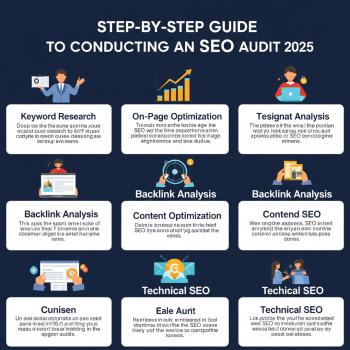
Posted on: 2 months ago
A Step-by-Step Guide to Conducting an SEO Audit in 2025
Off-Page SEO, OnPage SEO, SEO Auditing, SEO Guide2025, Technical SEO, website optimization
22 | 0 | 1
Search Engine Optimization (SEO) is no longer just about keywords and backlinks. In 2025, it’s a strategic game of delivering great user experiences, faster load times, relevant content, and clean technical performance. Whether you're a digital marketer, small business owner, or web developer, performing regular SEO audits is essential to ensure your site ranks well and meets user expectations.
Here’s a simple and unique step-by-step guide to conducting an SEO audit in 2025:
Step 1: Set Clear SEO Goals
Before diving into the technical details, define your objectives.
- Do you want more organic traffic?
- Are you trying to improve local search rankings?
- Do you want to fix a recent drop in visibility?
Clear goals help you focus your audit and measure success more effectively.
Step 2: Crawl Your Website
Use tools like Screaming Frog, Ahrefs Site Audit, or SEMrush to crawl your site. These tools will help identify:
- Broken links
- Redirect loops
- Duplicate content
- Missing meta tags
- Crawl errors
Make sure your XML sitemap and robots.txt are correctly configured.
Step 3: Evaluate On-Page SEO
Check every page for:
- Title tags (unique and optimized)
- Meta descriptions (compelling and within 160 characters)
- H1, H2 structure
- Internal linking
- Keyword placement and density
- Image alt texts
Consistency and clarity in your content architecture improve both SEO and user engagement.
Step 4: Review Technical SEO
Technical aspects can make or break your rankings. Assess:
- Page speed: Use Google PageSpeed Insights or GTMetrix.
- Mobile-friendliness: Ensure a responsive design.
- HTTPS security: A secure site builds trust and improves SEO.
- Core Web Vitals: Optimize LCP, FID, and CLS for better UX.
- Indexability: Ensure important pages are not accidentally marked “noindex”.
Step 5: Analyze Content Quality
High-quality, updated content matters more than ever. Ask:
- Is the content original and informative?
- Does it answer search intent?
- Are there content gaps?
- Are outdated blogs or product pages affecting performance?
Update or remove underperforming pages and focus on building topic clusters.
Step 6: Examine Off-Page SEO and Backlinks
Use tools like Ahrefs or Moz to:
- Review your backlink profile
- Identify toxic links and disavow them
- Analyze anchor text distribution
- Spot opportunities for guest posting or partnerships
Quality backlinks from authoritative sources are still one of the top ranking signals.
Step 7: Local SEO (If Applicable)
For businesses targeting specific areas:
- Ensure NAP (Name, Address, Phone) consistency across directories.
- Optimize Google Business Profile.
- Encourage and respond to reviews.
- Add local keywords and schema markup.
Step 8: Use Analytics to Track Performance
Connect Google Analytics 4 and Google Search Console:
- Monitor traffic sources, bounce rates, and conversions
- Identify high-performing and underperforming pages
- Spot technical errors and mobile usability issues
Data helps in making informed SEO decisions.
Step 9: Prepare an SEO Audit Report
Compile all findings into a report that includes:
- Issues found
- Recommended actions
- Priority level
- Tools used
- Metrics before and after an audit
This serves as a roadmap for your SEO strategy and is useful for clients or stakeholders.
Step 10: Act and Monitor Results
An audit means nothing without action. Fix issues step-by-step and track the impact using your defined goals. SEO is not a one-time effort—continue to audit quarterly or biannually.
Conducting an SEO audit in 2025 is about aligning your website with user intent, search engine requirements, and technical standards. When done right, it doesn’t just improve your rankings—it transforms your website into a high-performing, user-friendly experience that drives real business results
Welcome to CodePits.
CodePits provide a collection of tutorials about many programming languages like PHP, Laravel Framework, Codeigniter Framework, Mysql Database, Bootstrap Front-end Framework, Jquery, Node JS, Ajax Example, APIs, CURL Example, Composer Packages Example, AngularJS, Ionic Framework, etc. 🙌
Other Posts
Categories
Tags
Comment
 PR
PR Home
Home Demos
Demos Near By
Near By
Comments (0)
🤔
No comments yet, be the first to help
load more